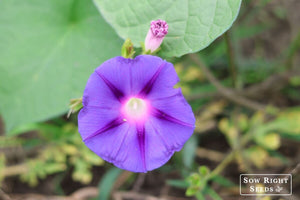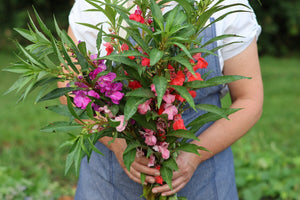How to Grow Blue Flax Flowers from Seed for Beauty and Utility
WildflowersLooking for a true blue flower that is low-maintenance? Take a look at Blue Flax wildflowers. They may look delicate, but these hardy perennials are easy to grow from seed. Traditionally used for rope-making due to its strong fibers, Blue Flax brings historical and practical value to your garden.

For thousands of years, flax plants have been cultivated for their versatile fibers, which are the source of real linen—a natural fiber used for clothing and rope. Blue Flax is grown today for its beautiful blooms, resilience, and utility.
Even if you’re not planning to harvest Blue Flax for its fibers, it’s fun to know that you could. And having a conversation piece in your flower garden is always nice! We’ll cover the basics of growing Blue Flax from seed.

How to Grow Blue Flax Flowers from Seed
Blue flax is often grown in a wildflower mix, where different flowers will bloom throughout the year. It grows best in cool or moderate weather.
You can easily start growing Blue Flax flowers from seed. Seeds can be started both inside and directly sown outdoors.

Blue Flax Seed Sowing Tips
-Don’t soak the seeds. (They get slimy)
-Direct sow seeds in spring. Seeds can also be sown in fall, usually mixed with other wildflowers.
-Lightly cover seeds with soil and keep the soil moist until seeds germinate.
-Seeds take 14 to 21 days to germinate.
-You can sow blue flax seeds densely or space them 10 to 12 inches apart.

Caring for Blue Flax Plants
You can grow Blue Flax by itself for a field of blue flowers. But it is known for mixing well with other wildflowers and can easily be a part of a mix of different colors and kinds of flowers.
Sun
Blue Flax prefers full sun and will produce more blooms when it receives at least 6 hours of daily sunlight. In hotter climates, it tolerates shade, which may prolong the blooming season.
Soil
Well-drained soil is important for blue flax plants. It thrives in poor soils that can be clay or sandy as long as they drain well.
Watering
This perennial variety of flax is drought tolerant, but young plants will need more water until their roots are well developed. Sufficient water will also result in bigger plants with more blooms.
Blue Flax Flowers and Seeds
Blue Flax flowers only last for a day, so they aren’t used as a cut flower. But they continually bloom from May through July, depending on the location and the heat.
The plants will produce seedheads as the blooms fall off. The seedpods will start out green and then turn to a golden flax color. Eventually, the pods will release the seeds. This natural self-seeding will keep flax flowers blooming year after year.
Another fun use of blue flax is for a foraging or pasture plant for chickens. Once the seed heads start developing, you can let your chickens wander through and eat the seeds. This is one way to increase the amount of omega-3 fatty acids in eggs.

Notes on Flaxseed
Besides its benefits as a strong fiber, flax has also been grown for its seeds. Linseed oil is made from flaxseed. Flaxseed has also gained popularity as a health food because of its fiber, omega-3 fatty acids, and lignins. It doesn’t hurt that it is also a very tasty seed. Flaxseed is crunchy with a nutty flavor. The seeds are easier to digest when they are ground up. Flaxseed can be easily added to smoothies and oatmeal for added flavor and nutrition. You only need a tablespoon for a healthy serving. Blue Flax flowers should be cooked before eating.

Blue Flax FAQs
Is Blue Flax invasive?
Blue flax is not considered invasive. It is a short-lived perennial that self-seeds.
Does Blue Flax need cold stratification?
Blue Flax seeds do not need cold stratification. They can be sown in early spring.
There’s more to beautiful Blue Flax flowers than meets the eye. These easy-to-grow perennials provide strong fibers for rope and nutritious seeds. Blue Flax offers low-maintenance charm and hardiness, whether planted alone or mixed with other wildflowers.
Transform your garden into a stunning meadow with heirloom seeds from Sow Right Seeds.
Popular Posts
-

Grow Morning Glory from Seed to Create a Lush Vertical Garden
-

Balsam: How to Grow Impatiens Balsamina Flowers from Seed






Leave a comment